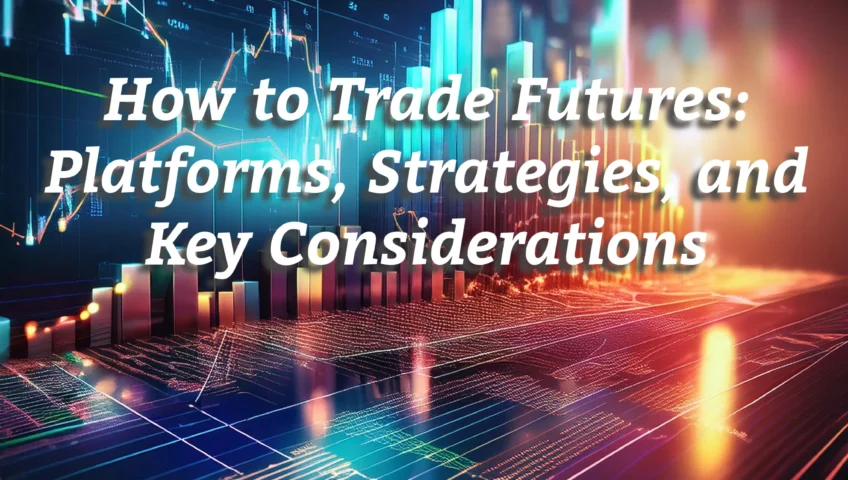
How to Trade Futures: Platforms, Strategies, and Key Considerations
Trade futures has been around since the mid-19th century, originally designed for farmers to lock in prices for crops like wheat. Today, futures have expanded to include a variety of assets such as stocks, commodities, currencies, and cryptocurrencies. This guide will explore how to trade futures, the benefits and risks involved, and what you need to know to get started.
Understanding Futures Trading
A futures contract is an agreement between two parties to buy or sell an asset at a specified price on a future date. While some futures lead to the physical delivery of goods, most are used by traders to speculate on price changes or hedge against risks in a portfolio. You can trade futures on various assets, including stock indices, energy, interest rates, and even cryptocurrencies. Many futures contracts are traded on centralized exchanges like the Chicago Mercantile Exchange (CME), while platforms like Binance offer perpetual futures contracts with no expiry date.

Pros and Cons of Futures Trading
Like any trading strategy, futures come with their own set of advantages and disadvantages. Understanding these is crucial whether you’re a beginner or an experienced trader.
Advantages:
- Leverage: Futures contracts allow traders to control large positions with a small initial investment through margin trading. This can lead to substantial gains if the market moves in your favor.
- Diversification: Futures offer exposure to a wide array of assets, from stock indexes to commodities like oil and livestock, helping diversify portfolios.
- Extended Trading Hours: Futures markets often operate almost around the clock, offering more opportunities for profit, especially during off-market hours.
- Hedging: Futures contracts provide an efficient way to hedge against market risks. For example, a trader can protect gains or mitigate losses in a volatile market.
Disadvantages:
- Complexity: Futures trading involves monitoring expiry dates, understanding contract specifications, and managing leverage—making it more complex than traditional stock trading.
- Over-Leverage Risk: While leverage can amplify profits, it can also magnify losses. Traders can lose more than their initial investment if the market moves against them.
- Managing Expiry Dates: Futures contracts have a set expiration date, and failure to manage this could lead to losses or physical delivery of an asset, such as oil or livestock.
- Physical Delivery: If you don’t roll over or close out a contract before it expires, you may be required to take physical delivery of the underlying commodity.
Choosing a Futures Trading Platform
When selecting a futures trading platform, consider the following factors:
- Ease of Use: The platform should be intuitive, especially if you’re new to futures trading.
- Order Types: Multiple order types, such as stop-loss and limit orders, help manage risk.
- Fees and Commissions: Compare costs to ensure you’re not overpaying in fees. Competitive pricing is crucial to long-term profitability.
Advanced traders might also want API access for algorithmic trading or a mobile app for trading on the go.
Developing a Futures Trading Plan
A well-crafted trading plan is essential for success. This plan should include your entry and exit strategies, risk management rules, and an understanding of market indicators. Traders often use technical analysis, such as moving averages, to spot trading opportunities, or fundamental analysis, like inventory reports, to guide their decisions.
Here are three common strategies:
- Long Position: Buy futures when you expect the price of an asset to rise.
- Short Position: Sell futures if you believe the price will drop.
- Spread: Use calendar spreads by buying one futures contract and selling another with a different expiry date, or by trading two related assets like crude oil and gasoline.
Key Concepts to Know
Before diving into futures trading, it’s important to understand contract specifications like contract size, tick size, and margin requirements. For instance, the E-mini S&P 500 contract represents $50 times the index value, and each tick (the smallest price movement) is $12.50. Knowing these details helps you calculate your potential risk and rewards.
Popular Futures Markets
Futures contracts are available for many asset classes, including:
- Equity Indexes: S&P 500, Nasdaq 100
- Commodities: Oil, natural gas, grains
- Currencies: EUR/USD, GBP/JPY
- Cryptocurrencies: Bitcoin, Ethereum
- Treasuries: U.S. government bonds
Steps to Start Trading Futures
- Learn the Basics: Understand how futures contracts work, including expiration dates and margin requirements.
- Assess Risks: Futures trading involves significant risk, particularly with leverage. Be sure you’re aware of these risks before proceeding.
- Choose a Market: Decide whether you want to trade stocks, commodities, or currencies, and narrow your focus.
- Formulate a Strategy: Will you take a long or short position? Or use a spread strategy to hedge your bets?
- Select a Trading Platform: Ensure it meets your needs for fees, functionality, and ease of use.
Example of a Futures Trade
Let’s say you want to short the E-mini S&P 500 futures contract because you believe the index will drop from its all-time high. The broker requires $12,000 in margin, and you risk 1% of your $125,000 trading account. By placing a stop-loss order $25 above your entry price, you limit your downside to $1,250 while targeting a $3,300 profit if the index falls to your target price.
Final Thoughts
Futures contracts provide an exciting way to speculate on or hedge against market movements. They offer the potential for significant profits but also carry substantial risks, especially due to the use of leverage. To succeed in futures trading, it’s essential to develop a robust trading plan, choose the right platform, and continuously monitor market conditions.
Frequently asked questions (FAQs) related to futures trading:
1. What is futures trading?
Futures trading involves buying or selling a contract that obligates the trader to purchase or sell an asset at a predetermined price on a specified future date. It allows traders to speculate on price movements or hedge against price changes in assets like commodities, stocks, currencies, or cryptocurrencies.
2. What’s the difference between futures and stocks?
When you buy a stock, you’re purchasing a share of ownership in a company. With futures, you’re entering into a contract to buy or sell an asset at a future date, without necessarily owning the asset itself. Futures also involve leverage, meaning you can control a large position with a smaller initial investment.
3. How does leverage work in futures trading?
Leverage in futures trading allows you to control a large contract value with a relatively small initial margin deposit. This amplifies both potential gains and losses, as your exposure to market movements is higher than your initial investment.
4. What are the risks of trading futures?
The main risks of futures trading include the potential for significant losses due to leverage, the complexity of managing expiry dates, and the possibility of being required to take physical delivery of an asset. If the market moves against your position, you can lose more than your initial margin.
5. What are margin calls in futures trading?
A margin call occurs when your account balance falls below the required maintenance margin due to losses in open positions. When this happens, your broker will ask you to deposit additional funds to cover the shortfall, or your positions may be liquidated to cover the losses.
6. Can I trade futures on any type of asset?
Yes, futures can be traded on a wide range of assets, including stock indices, commodities (like oil, gold, and corn), currencies, cryptocurrencies, interest rates, and bonds. Each asset class has its own specific futures contracts with varying contract sizes and expiry dates.
7. What happens if I don’t close a futures contract before it expires?
If you don’t close or roll over your futures position before the contract’s expiry, you may be obligated to take physical delivery of the asset (e.g., barrels of oil, livestock). In financial futures (like stock indices), this typically results in a cash settlement instead of physical delivery.
8. What is the difference between long and short futures positions?
A long position in futures means you expect the price of the underlying asset to rise, and you profit if it does. A short position means you expect the price to fall, and you profit when the asset decreases in value.
9. What are perpetual futures contracts?
Perpetual futures contracts, commonly used in cryptocurrency trading, are futures contracts that don’t have an expiration date. This allows traders to hold positions indefinitely without worrying about contract expiration and rolling over to a new contract.
10. How do I choose a futures trading platform?
When choosing a futures trading platform, consider factors such as ease of use, order types available (e.g., stop-loss, limit orders), fees and commissions, and mobile trading features. Advanced traders may also want access to APIs for algorithmic trading.
11. What is the tick size in futures trading?
The tick size refers to the minimum price movement a futures contract can make. For example, in the E-mini S&P 500 futures contract, one tick equals 0.25 index points, or $12.50.
12. What is a futures spread strategy?
A futures spread involves taking two positions in related futures contracts. For example, you might buy one futures contract and sell another on the same asset with a different expiration date, or on two related assets (like crude oil and gasoline) to profit from price differences.
13. Is futures trading suitable for beginners?
Futures trading can be complex and risky, especially due to the use of leverage. While beginners can trade futures, it’s essential to thoroughly understand the market, start with a well-defined trading plan, and manage risks carefully.
14. What are the tax implications of futures trading?
Tax rules for futures trading vary by country, and in many jurisdictions, profits from futures may be treated differently from stock trading. In the U.S., for example, futures contracts may be subject to the “60/40 rule,” where 60% of gains are taxed as long-term capital gains and 40% as short-term, regardless of how long the position is held.
15. What are the key elements of a futures trading plan?
A good futures trading plan should include entry and exit strategies, risk management rules (such as using stop-loss orders), and clearly defined goals for each trade. Traders often base their strategies on technical or fundamental analysis.
